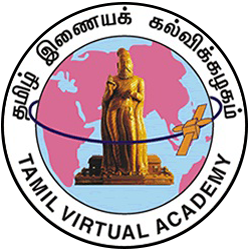Primary tabs
-
D03131 Ani Ilakkanam- A General Introduction
This lesson offers a brief introduction to ani ilakkanam- the grammar concerning the use of figures of speech. Traditionally, Tamil grammar is divided into 5 parts-viz. ‘ezhuthu’ or (letter), ‘sol’ or (word), ‘porul’ or (subject), ‘yappu’ i.e., (prosody or metrics) and ‘ani’ or (figures of speech). Tamil grammar texts are classified on the basis of the number of grammatical expositions found in them. For example, ‘Tholkappiam’ deals with 3 aspects of grammar- ‘ezhuthathigaaram’, ‘solathigaaram’ and ‘porulathigaaram’. Hence, it comes under ‘Moovagai Ilakkana Nool’, i.e., the text that contains 3 types or (moovagai) of grammatical expositions. Likewise, there are ‘Aivagai Ilakkana Nool’ and ‘Aruvagai Ilakkana Nool’, texts that contain 5 and 6 types of grammar respectively. There are also grammar texts that speak of just one aspect of grammar- ‘Thanithani Ilakkana Noolgal’.
‘Anikal’ or figures of speech are the decorative aspects of a language. They are used to add beauty to the written text. The word ‘ani’ in Tamil means ‘beauty’. While the grammar concerning the use of ‘ezhuthu’ or (letter), ‘sol’ or (word), ‘porul’ or (subject) and ‘yappu’ or (prosody) differ from language to language, ani ilakkanam is common to all languages. It is believed that the concept of ani ilakkanam existed even before the time of ‘Tholkappiam’, the most ancient grammar text. ‘Dandialangaaram’, the authoritative grammatical treatise on ani, divides ani ilakkanam into 3 sections: viz. ‘Pothuvaniiyal’, ‘Porulaniiyal’ and ‘Solaniiyal’. ‘Pothuvaniiyal’ contains information on anigal or figures of speech in general. ‘Porulaniiyal’ explains the anigal or figures of speech that are based on the subject or ‘porul’. ‘Solaniiyal’ deals with anigal that are based on words (sol). Anigal or figures of speech have 2 important functions. They aid in understanding the meaning of a text i.e., (porulpulappaadu) and they enhance the beauty of the text i.e., (azhagupaduthal).
The chapter on ‘uvamaviyal’ in ‘Tholkappiam’ was the basis for the ani ilakkana noolgal that were written later. ‘Dandialangaaram’, the most famous grammar text on anigal written by Dandi, shows the influence of ‘Tholkappiam’ and other Sanskrit grammar texts. The history and growth of ani ilakkanam is classified as the growth of ‘porul ani’ and the growth of ‘sol ani’. ‘Yapparungala Viruthi Urai’, ‘Senthan Divaagaram’, ‘Veerasozhiyam’, ‘Dandialangaaram’, ‘Maaranalangaaram’, ‘Thiruthani Visagaperumal Aiyyar Ani Ilakkanam’ and Kuvalaiaanandam’ are texts that contain information on the various types of ‘porul ani’. The Thevaram Hymns of Thirugnanasambandar, ‘Veerasozhiyam’, ‘Divaagaram’, ‘Dandialangaaram’, ‘Yapparungalam’, ‘Yaaparungala Urai’, ‘Maranalangaram’ and ‘Maranalangara Urai’ are texts that deal with the different types of ‘sol ani’. Of the ainthilakkana noolgal, ‘Veerasozhiyam’, ‘Ilakkana Vilakkam’, ‘Thonnool Vilakkam’, ‘Muthuveeriyam’ and ‘Swamiatham’ contain detailed expositions on ani ilakkanam along with other 4 aspects of grammar. Among the aruvagai ilakkana noolgal, ‘Vannacharabam’ deals with ani ilakkanam besides the other 5 aspects of grammar. The ‘Thanitha Ani Ilakkana Noolgal’ that deal exclusively with ani ilakkanam are ‘Dandialangaaram’, ‘Maaranalangaaram’, ‘Chandiralogam’, ‘Kuvalaiaanandam’, ‘Dhonivilakku’ and ‘Chithirakavigal’. Of these, ‘Dandialangaaram’ written by Dandi is the most famous grammar text on anigal. Also known as ‘Aniathigaaram’, ‘Dandialangaaram’ seeks to explain the anigal with suitable examples from literary texts.


